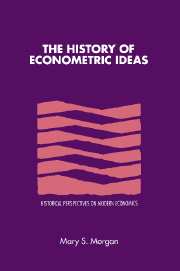Book contents
- Frontmatter
- Contents
- List of figures
- Preface
- Acknowledgements
- Introduction
- Part I Business cycles
- Introduction to business cycles
- 1 Sunspot and Venus theories of the business cycle
- 2 Measuring and representing business cycles
- 3 Random shocks enter the business cycle scene
- 4 Tinbergen and macrodynamic models
- Part II Demand analysis
- Part III Formal models in econometrics
- Conclusion
- References
- Index
1 - Sunspot and Venus theories of the business cycle
Published online by Cambridge University Press: 26 October 2009
- Frontmatter
- Contents
- List of figures
- Preface
- Acknowledgements
- Introduction
- Part I Business cycles
- Introduction to business cycles
- 1 Sunspot and Venus theories of the business cycle
- 2 Measuring and representing business cycles
- 3 Random shocks enter the business cycle scene
- 4 Tinbergen and macrodynamic models
- Part II Demand analysis
- Part III Formal models in econometrics
- Conclusion
- References
- Index
Summary
Wiliam Stanley Jevons was one of the first economists to break away from the casual tradition of applied work which prevailed in the nineteenth century and combine theory with statistical data on many events to produce a general account of the business cycle. Then, in the early twentieth century when statistical work was still uncommon, Henry Ludwell Moore adopted more sophisticated techniques to develop an alternative theory of the cycle. This chapter relates how Jevons and Moore set about building their theories. Both of them relied heavily on statistical regularities in the formation of their hypotheses, which featured periodic economic cycles caused by exogenous changes in heavenly bodies. The development of the econometric approach to business cycle analysis between the 1870s and the 1920s is shown in their work, and in its changing reception from reviewers. Jevons' and Moore's cycle work deserves to be taken seriously as pioneering econometrics, yet the periodic cycle programme they initiated did not prove to be very influential. The last section of this chapter explores why this was so.
Jevons' sunspot theory
Jevons' sunspot theory of the cycle has always been the object of mirth to his fellow economists, despite the fact that by the time he began to work on the subject in the 1870s he was already well known and distinguished for his contributions to mainstream economics. He was also renowned for statistical analyses of various problems, particularly the problem of index numbers.
- Type
- Chapter
- Information
- The History of Econometric Ideas , pp. 18 - 39Publisher: Cambridge University PressPrint publication year: 1990

